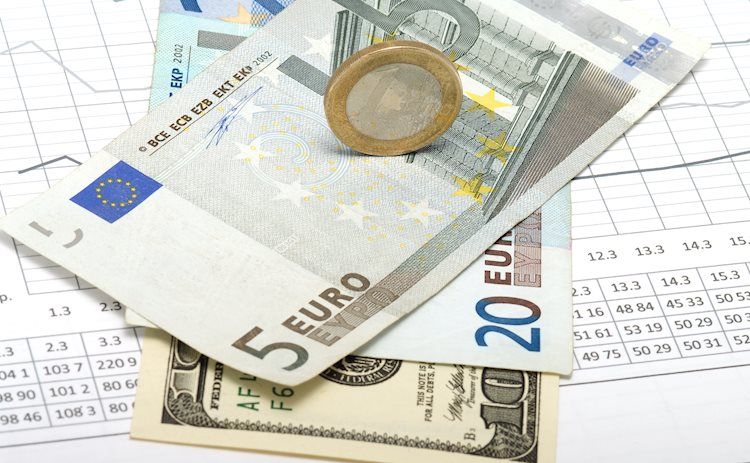- EUR/USD trades in a tight channel above 1.0800 on Monday.
- The near-term technical outlook doesn’t point to a buildup of directional momentum.
- The pair could encounter stiff resistance at 1.0870.
EUR/USD seems to have gone into a consolidation phase above 1.0800 early Monday after snapping a three-week losing streak. The near-term technical outlook highlights the pair’s indecisiveness.
The US Dollar (USD) gathered strength in the American session on Friday and caused EUR/USD to drop below 1.0800. The data released by the US Bureau of Labor Statistics showed that Nonfarm Payrolls rose by 303,000 in March. This reading surpassed the market expectation of 200,000 by a wide margin and provided a boost to the USD with the immediate reaction.
Later in the session, the USD struggled to continue to outperform its rivals as it failed to attract demand in the risk-positive market atmosphere. In turn, EUR/USD erased its daily gains and closed the week in positive territory.
Euro price today
The table below shows the percentage change of Euro (EUR) against listed major currencies today. Euro was the strongest against the Swiss Franc.
| USD | EUR | GBP | CAD | AUD | JPY | NZD | CHF | |
| USD | -0.04% | -0.04% | -0.11% | -0.27% | 0.10% | -0.20% | 0.14% | |
| EUR | 0.04% | 0.01% | -0.07% | -0.22% | 0.14% | -0.14% | 0.18% | |
| GBP | 0.03% | 0.00% | -0.09% | -0.23% | 0.12% | -0.16% | 0.17% | |
| CAD | 0.11% | 0.07% | 0.08% | -0.15% | 0.21% | -0.08% | 0.25% | |
| AUD | 0.27% | 0.21% | 0.22% | 0.15% | 0.36% | 0.07% | 0.38% | |
| JPY | -0.10% | -0.13% | -0.12% | -0.18% | -0.36% | -0.26% | 0.04% | |
| NZD | 0.19% | 0.14% | 0.15% | 0.08% | -0.07% | 0.29% | 0.32% | |
| CHF | -0.14% | -0.19% | -0.17% | -0.25% | -0.40% | -0.04% | -0.33% |
The heat map shows percentage changes of major currencies against each other. The base currency is picked from the left column, while the quote currency is picked from the top row. For example, if you pick the Euro from the left column and move along the horizontal line to the Japanese Yen, the percentage change displayed in the box will represent EUR (base)/JPY (quote).
The US economic docket will not feature any high-impact data releases on Monday. In the meantime, US stock index futures turned positive on the day after spending the Asian session in negative territory. In case risk flows continue to dominate the action in the American trading hours, the USD could have a difficult time holding its ground.
EUR/USD Technical Analysis
The 200-period Simple Moving Average aligns as first resistance at 1.0850. If the pair rises above that level, 1.0870 (Fibonacci 61.8% retracement of the latest downtrend) could act as stiff resistance before 1.0900 (Fibonacci 78.6% retracement) could be targeted.
On the downside, interim support is located at 1.0815 (Fibonacci 38.2% retracement) ahead of 1.0780 (Fibonacci 23.6% retracement) and 1.0760 (static level).
Euro FAQs
The Euro is the currency for the 20 European Union countries that belong to the Eurozone. It is the second most heavily traded currency in the world behind the US Dollar. In 2022, it accounted for 31% of all foreign exchange transactions, with an average daily turnover of over $2.2 trillion a day. EUR/USD is the most heavily traded currency pair in the world, accounting for an estimated 30% off all transactions, followed by EUR/JPY (4%), EUR/GBP (3%) and EUR/AUD (2%).
The European Central Bank (ECB) in Frankfurt, Germany, is the reserve bank for the Eurozone. The ECB sets interest rates and manages monetary policy. The ECB’s primary mandate is to maintain price stability, which means either controlling inflation or stimulating growth. Its primary tool is the raising or lowering of interest rates. Relatively high interest rates – or the expectation of higher rates – will usually benefit the Euro and vice versa. The ECB Governing Council makes monetary policy decisions at meetings held eight times a year. Decisions are made by heads of the Eurozone national banks and six permanent members, including the President of the ECB, Christine Lagarde.
Eurozone inflation data, measured by the Harmonized Index of Consumer Prices (HICP), is an important econometric for the Euro. If inflation rises more than expected, especially if above the ECB’s 2% target, it obliges the ECB to raise interest rates to bring it back under control. Relatively high interest rates compared to its counterparts will usually benefit the Euro, as it makes the region more attractive as a place for global investors to park their money.
Data releases gauge the health of the economy and can impact on the Euro. Indicators such as GDP, Manufacturing and Services PMIs, employment, and consumer sentiment surveys can all influence the direction of the single currency. A strong economy is good for the Euro. Not only does it attract more foreign investment but it may encourage the ECB to put up interest rates, which will directly strengthen the Euro. Otherwise, if economic data is weak, the Euro is likely to fall. Economic data for the four largest economies in the euro area (Germany, France, Italy and Spain) are especially significant, as they account for 75% of the Eurozone’s economy.
Another significant data release for the Euro is the Trade Balance. This indicator measures the difference between what a country earns from its exports and what it spends on imports over a given period. If a country produces highly sought after exports then its currency will gain in value purely from the extra demand created from foreign buyers seeking to purchase these goods. Therefore, a positive net Trade Balance strengthens a currency and vice versa for a negative balance.

